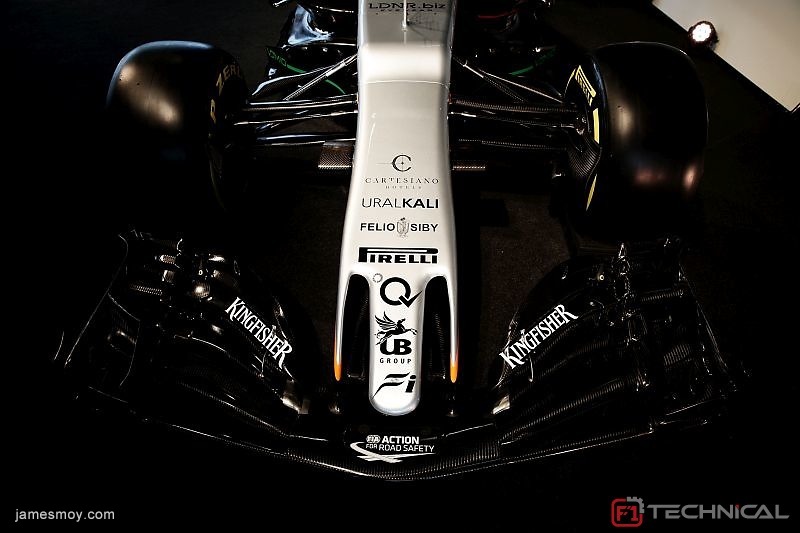Force India VJM10 - Technical impression

The parts at the front will probably draw everybody's attention, as the nose cone looks very distinct in comparison with the previous cars launched. It is however the same concept Force India started using during the 2015 Silverstone Grand Prix and beyond. The so called nostril nose. This is the same concept but brought to dramatic proportions.
A recap of why they do this: The frontal crash structure is not regulatory allowed to consist out of 2 parts for any given cross section when viewed from the side or front. This is to prevent teams from making holes in the structure and allowing airflow to get through, something that is quite beneficial as this flow can be used to feed the floor and splitter.
The next video shows how Force India circumvents the rule:
A big thanks to Mario Keszeli from techf1les for this video
Basically the holes are made at such an angle that no possible cross section either viewed from the front or side dimensions can divide the structure in 2 fully separated parts, as the hole is only possible to view in a diagonal position, which is not regulated. As such this is a legal solution.
As mentioned, the intention is to get more flow underneath the nose. This year these holes are lengthened across the crash structure down to its tip, further increasing air volume passing through the nose cone. This is partially made possible due the regulation allowing for a longer crash structure this year, as well as further strides in carbon fibre rigidity and layering. Remember that these nose cones have to pass very harsh crash tests!
The front wing is also an evolution from last year, taken further to extreme heights. Last year around the middle of the season, Force India introduced a similar philosophy to the one Mercedes used (and perhaps still is using), of separate outwash tunnels to better divert flow around the front tyre. Given that the space between the outer edge of the wing and the outer edge of the front tyre has increased, the tunnel had to be further twisted and enlarged to keep depriving the tyre from flow as a means to reduce drag and turbulence. This comes at a cost of peak downforce as wing surface normally used for producing downforce is sacrificed. With for instance Sauber going a completely different route, it remains to be seen who will ultimately be right on this.

Further up, there is a distinct bump at the front bulkhead of the nose. Although there is a vanity panel present, the panel is not allowed to go beyond a certain height so Force India was not able to smooth out this bump. This might cause flow separation, something Force India looks willing to take. The bump is there because the push rod connection points have been moved up extremely high. The reason why is not known for the moment, but a possibility is that Force India is looking into copying Mercedes' hydraulic suspension solution, which puts more suspension parts in the front bulkhead.
The bargeboards are less aggressive, with a rather ordinary set up, but detailed nonetheless with its half-segregations slit top down. It also features an extra, smaller element at the front of the bargeboard, very reminiscent to 2007-2008 when a similar solution was applied in that area, fine-tuning the airflow structures around it. The sidepod turning vanes are present on top of the sidepods. Force India is not showing its feathers yet in this area.

While the inlets are quite small, the sidepods themselves ultimately extent to the maximum width. However, Force India does follow the trend of heavy undercutting the sidepods.

From their widest point, they very quickly taper back into a very slender waist at the back, leaving ample floor exposed rearwards. Do note the small cooling outlet on top of the coke bottle at the intersection with the shark fin.
Speaking of which, Force India opted to use the maximum allowed space for its sharkfin. Where other teams shape it at the back, it's rectangular at the back of this car, maximizing the amount of surface to control flow while the car is yaw, but also at the cost of controlling the vortices rolling off the shark fin.
Finally the rear wing is just like the Renault one, supported by a single pylon connected from the DRS actuator pod right to right through the exhaust pipe. The endplate also feature louvres introduced by Toro Rosso last year. This is an area we will clearly see a lot of converge among the teams the same set of ideas.



